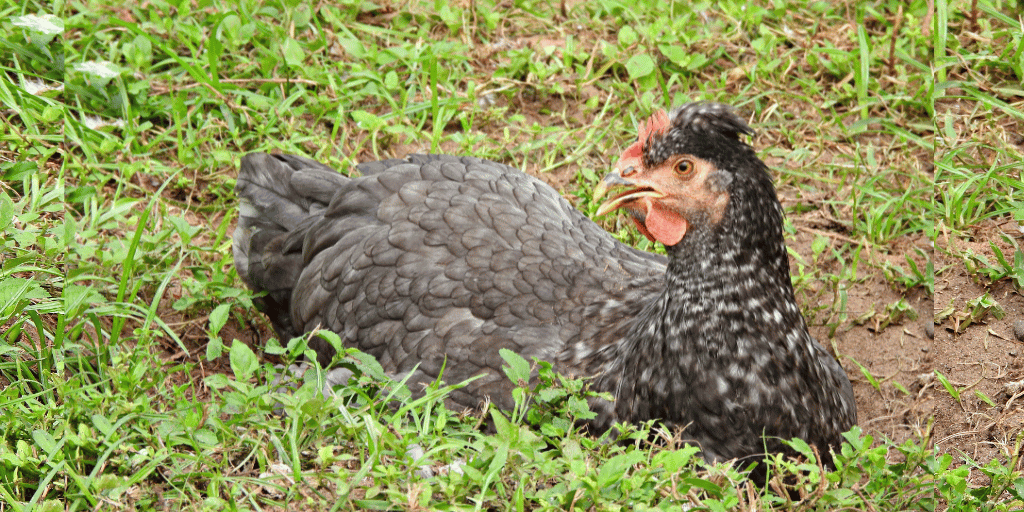
Have you heard about Olive Egger chickens? If you like olive-colored eggs, this breed will motivate you in your backyard farming.
Backyard chicken raisers enjoy raising Olive Eggers. They are beautiful hybrid birds.
If you’re considering adding this breed to your flock or are just interested, this guide will answer every question.
This breed information covers Olive Egger Chickens’ history, characteristics, temperament, eggs, size, lifespan, and care guide.
What is an Olive Egger Chicken?
Olive Egger chickens are rare hybrids that are popular. They’re developed by crossing dark brown and blue egg-laying chicken breeds.
These hybrid chickens lay gorgeous olive eggs. Their egg color and appearance are unique.
Olive Egger hens are black, brown, and gray. Their olive-colored eggs fill your basket.
Olive Eggers are appreciated for their beauty, hardiness, and sociability.
They are good foragers and low-maintenance, ideal for backyard and large chicken flocks.
Olive Egger chickens lay an excellent amount of eggs. However, their olive-colored eggs, flexibility, and uncommon look make them excellent new-generation hybrids.
Whether you’re a backyard hobbyist or commercial farmer, this hybrid chicken variety brings beauty to your chicken coop.
Origins and History of Olive Egger Chickens
Because Olive Eggers are hybrid chickens, the APA and other major poultry organizations do not recognize them.
In 1842, Chinese chickens were mixed with indigenous breeds in England, getting into the cross-breeding craze.
Farmers crossed breeds with qualities to test this. More researchers joined this approach after the discovery of the chicken.
The Olive Egger chicken family includes blue egg-laying breeds like Araucana or Ameraucana and dark brown breeds like Marans or Welsummer.
They crossed-bred for healthier, robust, and adaptable chicks. But in the end, trial and error created Olive Egger chickens.
Because Olive Egger Chickens are not developed to a standard, their look, size, and personality vary.
Unique Features of Olive Egger Chickens
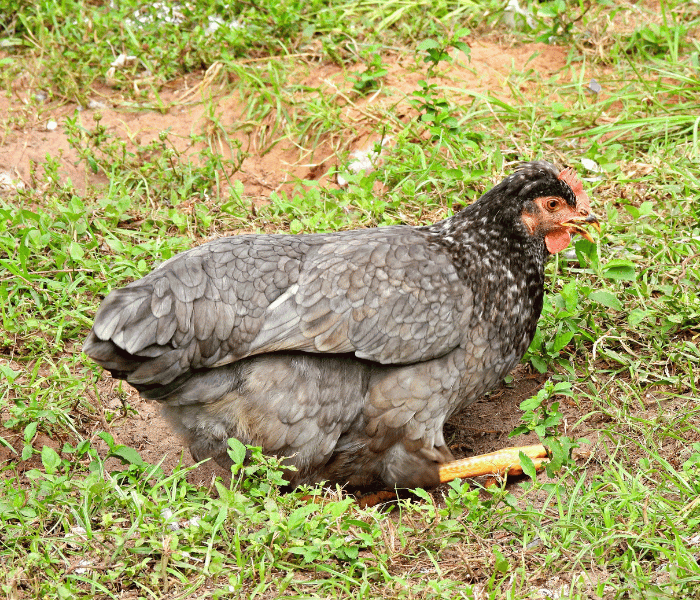
Egg color distinguishes Olive Egger Chickens. Hobbyists and professional egg producers love olive-colored eggs because they are beautiful, nutritious, and tasty.
Olive Egger eggs can be green or brown, depending on the crossbreeding.
Olive Eggers’ diverse appearance is another unique trait. They can have many colors, patterns, and feather types because they are a hybrid breed with no standard appearance.
Olive Egger flocks are diverse and attractive, making them ideal for backyard coops.
So, Olive Eggers can have Ameraucanas’ tufted ears, beards, and muffs or Marans’ feathered legs and feet. This diversifies and beautifies your Olive Egger flock.
Olive Egger Chicken Lifespan
Olive Egger Chickens live 5–8 years, like other chicken breeds.
Some individuals may live 10 years or more with proper care and management.
A predator-safe environment, good nutrition, and regular checkups are essential for your Olive Egger Chickens’ long and happy life.
Olive Egger Chicken Temperament and Personality
Olive Egger roosters and hens are gentle and docile. The peaceful and easygoing attitude makes them ideal for backyard flocks and families. Due of genetic variation, personalities vary.
The Olive Egger breed is known for its gentleness and non-aggression. They care over their chickens and safeguard their flock. Olive Eggers are docile and rarely attack humans or other animals, unlike some roosters.
They are easy to handle and interact with because they are not flighty. Olive Eggers is outgoing and nice with kids. These adventurous birds like to explore. They also generate less noise in the area due to their calmness.
Olive Eggers can adjust to diverse weather and are friendly. They withstand hot summers and chilly winters well.
Olive Eggers Color Varieties or Breed Standards
Olive Eggers have no recognized breed standards or color varieties. Blue and dark brown egg layers were crossed to create a hybrid chicken.
The Olive Egger chickens vary in appearance and egg color depending on the breeds utilized. They lay dark olive green to khaki color eggs.
Olive Eggers are medium-sized chickens with black or gray plumage. No breed standards exist for Olive Eggers, although they are amiable and docile.
Types of Olive Egger Chickens: Chart and Their Eggs
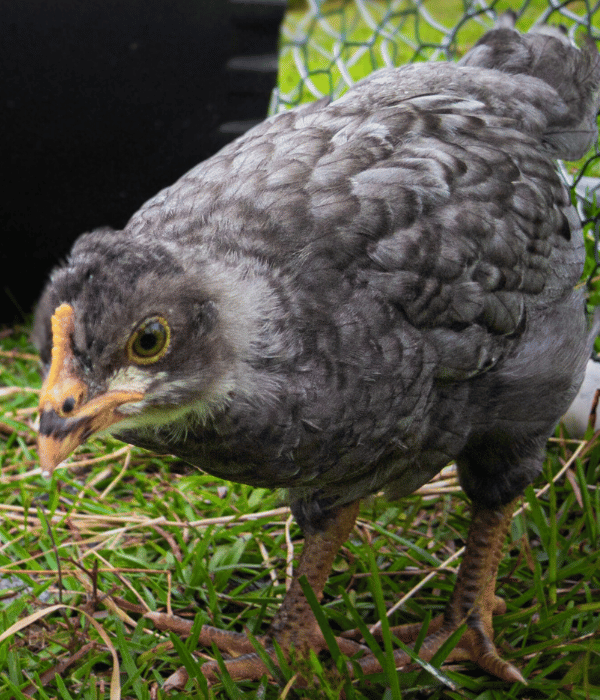
Various types of Olive Egger chickens are based on the crosses used to create them. Here is a chart showcasing some common crosses and the egg colors they produce:
Blue Ameraucana x Dark Brown Layer = Olive Green Eggs
Cream Legbar x Dark Brown Layer = Light Olive Green Eggs
Welsummer x Blue Ameraucana = Dark Olive Green Eggs
Marans x Cream Legbar = Khaki Green Eggs
Australorp x Cream Legbar = Light Green Eggs
Generally, egg colors may vary during cross.
Olive Egger Chicken Appearance
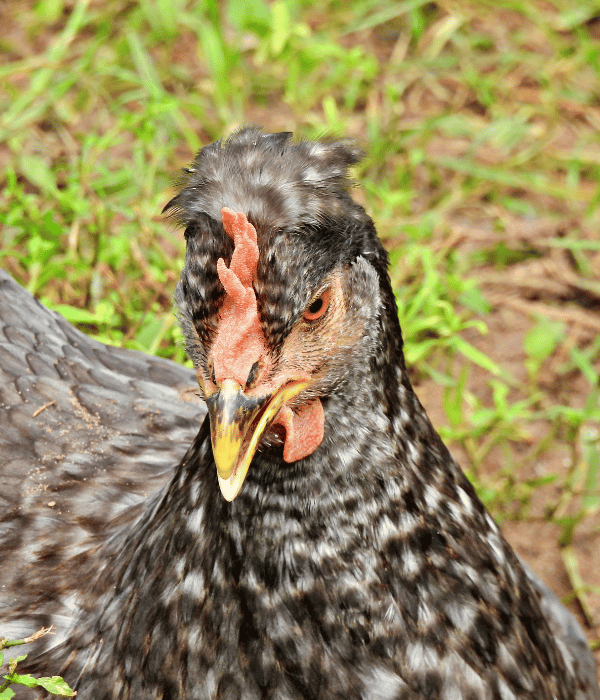
Olive Egger chickens are stunning and unusual. While Olive Eggers have no recognized breed criteria, their appearance can vary greatly depending on their parents.
Stocky roosters and hens are medium-sized birds with white skin, feathers, beaks, and feet.
Olive Eggers’ feather colors and patterns vary, making each bird distinctive. Their feathers might be brown, black, gray, or a mix.
Legs and toes might be yellow to gray. Olive Eggers usually have wattles and a pea comb. Different earlobe colors are possible.
Olive Egger hens have unusual egg colors. They are bred to deposit eggs in dark olive green, light green, or khaki. Poultry fans love these unusual-colored eggs, which can spice up any egg collection.
Olive Egger hens are attractive, gentle, and friendly. They tolerate diverse weather and get along with other hens.
Their calmness and beauty make them attractive for backyard flocks and those wanting an easy-to-handle breed.
Olive Egger Egg Production and Hens Broodiness
Olive Egger hens are popular among poultry lovers because they lay unusual eggs. These extraordinary hybrid chickens are known for their colorful and large eggs.
These hybrid hens start laying eggs around 5-6 months of age. They mostly lay olive-green color eggs.
But don’t worry if you get blue-green, brown, and pink eggs. Depending upon the primary crossbred chicken breed, they may sometimes lay these colored eggs.
These hybrid hens lay eggs year-round for their owners. These hybrid hens typically lay 150-200 medium-sized eggs every year.
This makes them a stable source of fresh eggs for everyday breakfast.
Olive Egger eggs are well-known for their quality. Thicker eggshells provide improved protection and durability.
The color and nutrients make the yolks a healthy addition to any dish. Olive Egger eggs have less cholesterol than regular eggs.
The hybrid hens rarely sit on their eggs. This can help people who want reliable egg production without broody hens.
Olive Egger Size & Weight
On average, Olive Egger hens weigh 6-7 lbs, and roosters weigh 7–8 lbs.
The weight differs because they are hybrids, and the gene differs according to their parent bird.
Olive Eggers are medium-sized chickens. They are compact with a muscular chest and legs.
Their size makes them ideal for backyard flocks because they produce much meat and eggs and can easily live in small spaces.
Olive Egger birds are popular with poultry lovers because of their size and weight.
These hens are distinctive and worth raising for their colorful eggs or as a dual-purpose breed.
Olive Egger Baby Chicks
Olive Egger baby chicks are adorable little birds. They have fluffy soft feathers, and they act in a curious way. They want to learn about everything around them.
These baby chicks can be many different colors and patterns. This depends on what kind of chickens were their parents. The different looks make them fun to see in your backyard chicken coop.
Like all baby chicks, it is important to take good care of Olive Eggers when they are young. They need a warm, dry place to stay like brooder.
You must give them food made for their age. And they need room to move around and grow bigger. If you do these things, the baby chicks will stay healthy.
Olive Egger Hen vs. Rooster: Differences and Similarities
Olive Egger hens and roosters are special birds. Their feathers come in shades of brown, black, and gray. They are medium-sized, with a thick coat of feathers.
The roosters have brighter feathers than the hens. Roosters also have bigger combs and wattles on their faces. These make them look more striking.
Roosters are bigger and stronger than the hens. They have broader chests and longer tail feathers. Size is one way to tell them apart.
Both Olive Egger hens and roosters enjoy finding food on the ground. They scratch and peck to get insects and seeds. But roosters can act tough when guarding their flock.
Only hens lay eggs, never the roosters. Olive Egger hens lay special eggs in olive shades. The eggs might be olive green, blue, or have hints of brown.
Compared to roosters, the hens are smaller and slimmer. Their combs and wattles are not as big or noticeable.
There can be differences and likeness in how Olive Egger hens and roosters look and behave. But a lot depends on the parents’ traits and upbringing.
What fascinates you the most about these beautiful fowl? Their unique eggs or their striking feathers?
Caring for Olive Egger Chickens: Tips and Guidelines
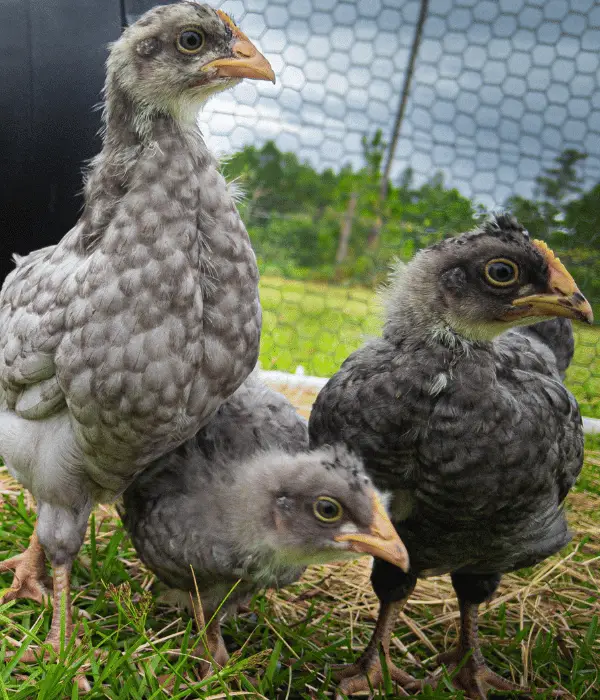
Caring for Olive Egger Chickens is relatively straightforward, but there are some essential tips and guidelines to keep in mind to ensure their health and happiness.
Provide a cozy coop: Taking care of Olive Egger chickens is fun and rewarding. To keep them safe and happy, set up a cozy coop with plenty of space to move around. The coop must contain all proper ventilation, safety, cozy living laying, safe fencing and perching space.
Predator safety: Make sure it’s secure from predators like foxes or raccoons with sturdy fencing and latches. Keep the coop clean and well-ventilated for their health.
Feed your Olive Egger hens a balanced diet with commercial chicken feed, fresh veggies, insects, and worms. Proper nutrition helps them stay healthy and lay lots of eggs.
Adequate water supply: Always provide clean, fresh water, especially on hot days, to prevent dehydration. Check and refill their waterer frequently.
Health checks: Keep an eye on your Olive Eggers’ health. If they seem tired, not eating, or acting strange, it could mean they’re sick. Don’t hesitate to contact a vet for help to diagnose and treat any illnesses.
Dust baths: Olive Eggers love taking dust baths to keep their feathers clean and pest-free. Set aside a shaded area with loose soil or sand for them to dig and roll around in.
Olive Egger chickens enjoy taking dust baths to keep their feathers clean and free from parasites. Allow these birds to engage in this natural behavior by providing them with a dry soil or sand area.
Give them time with other flocks: These hybrid chickens are social creatures and love foraging together in groups. It is best to keep them in a flock or introduce similar chicken breeds to provide them with companionship.
Allow free ranging: Give your Olive Egger chickens the opportunity to run freely in a supervised area. This allows them to exercise, stimulate their minds, and engage in their natural foraging behavior.
Nesting boxes: Provide cozy nesting boxes for your Olive Egger chickens to lay their eggs. Line the boxes with clean straw or wood shavings and place them in a quiet, secluded area. Consider building high-quality chicken nesting boxes yourself for optimal comfort.
Give space to roost: Olive Egger chickens have a natural tendency to perch and roost. To accommodate their nighttime roosting habits, install sturdy perches at various heights within their coop.
Olive Egger Common Health Issues
Olive Egger can be susceptible to specific health issues like all chicken breeds. Some of the most common health concerns include:
Keeping birds healthy is a big job. So, look out for parasites like mites and lice. They can make birds feel bad and lose feathers. Check your birds often for these pests and get rid of them right away.
Breathing problems like coughing, sneezing, and wheezing can happen when birds don’t get enough fresh air or live too close together. These are signs of respiratory infections like mycoplasma and infectious bronchitis. If you see these symptoms, give your birds medicine and extra care.
Olive Egger hens sometimes can’t lay eggs properly. The egg gets stuck inside, which is very dangerous, called egg binding. If this happens, take your hen to the vet quickly to save her life.
Birds need the right foods to stay healthy. A poor diet causes problems like weak eggs, brittle bones, and other issues. Make sure your birds eat a balanced, nutritious diet with all the foods they need.
Frequently Asked Questions About Olive Egger Chickens
Here are some of the most commonly asked questions about Olive Egger Chickens:
How many eggs does Olive Egger lay?
Olive Egger hens typically lay around 150-200 eggs annually, although this can vary depending on age, health, and environment. They are reliable layers and popular for backyard chicken keepers looking for colorful eggs.
When do Olive Egger start laying eggs?
Olive Egger hens typically begin laying eggs between 5–7 months of age. However, this can vary depending on diet, environment, and genetics. Proper nutrition and comfortable living space are essential to ensure healthy egg production.
Are Olive Egger hens broody?
Some Olive Egger hens may be more prone to going broody and sitting on their eggs, while others may not display this behavior at all. It varies from bird to bird.
If a broody Olive Egger is desired, it is crucial to provide a suitable nesting area and regular egg collection to prevent her from accumulating too many eggs.
What color are Olive Egger chickens?
Olive Egger Chickens can come in various colors and patterns, from black and blue to red and brown.
What size eggs do Olive Egger lay?
Olive Egger hens typically lay medium to large-sized eggs, with an average weight of around 50-60 grams.
How long do Olive Egger chickens live?
Olive Egger Chickens can live for an average of 5-8 years, although some individuals may live longer with proper care and management.
How often do Olive Egger lay eggs?
Olive Egger hens typically lay around 200–250 eggs yearly, or around 4-5 eggs per week during peak production.
How big do Olive Egger chickens get?
Olive Egger Chickens can vary in size depending on the specific crossbreeding, but generally, they are medium to large birds. Roosters weigh 7-8 pounds, while hens typically weigh 6-7.
Are Olive Egger friendly?
Olive Egger Chickens can be friendly and sociable, although this can vary depending on the individual bird’s personality and upbringing.
Are Olive Egger chickens cold-hardy?
Olive Egger Chickens are mostly hardy birds that can handle cold temperatures but may need additional protection during extreme weather conditions.
Conclusion: Are Olive Egger Good for Your Backyard Coop?
In conclusion, Olive Egger Chickens are a fascinating and unique breed that can make a great addition to any backyard coop.
Their beautiful olive-colored eggs, diverse appearance, and curious personalities make them popular among hobbyists and professional egg producers.
As with any breed, it’s essential to carefully consider their care requirements, temperament, and health issues before adding them to your flock.
But with proper care and management, Olive Egger Chickens can provide years of enjoyment and delicious eggs for you and your family.


Leave a Reply